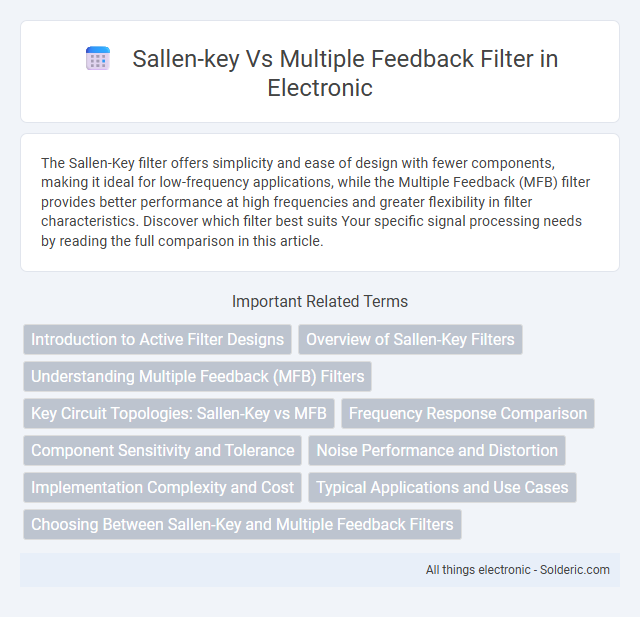The Sallen-Key filter offers simplicity and ease of design with fewer components, making it ideal for low-frequency applications, while the Multiple Feedback (MFB) filter provides better performance at high frequencies and greater flexibility in filter characteristics. Discover which filter best suits Your specific signal processing needs by reading the full comparison in this article.
Comparison Table
| Feature | Sallen-Key Filter | Multiple Feedback (MFB) Filter |
|---|---|---|
| Topology | Voltage follower based | Feedback through multiple components |
| Complexity | Simple, fewer components | More complex, more components |
| Gain Capability | Supports unity or higher gain | Gain limited, typically less than or equal to unity |
| Frequency Range | Effective at low to medium frequencies | Extends to higher frequencies |
| Noise Performance | Moderate noise due to fewer components | Better noise performance, improved linearity |
| Q Factor Control | Adjusted by component ratios, limited range | Wide Q factor tuning available |
| Stability | Generally stable, sensitive to capacitor tolerance | Stable with careful design, sensitive to resistor tolerance |
| Applications | Audio filters, low-frequency signal conditioning | High-frequency filtering, precise notch and bandpass filters |
Introduction to Active Filter Designs
Sallen-Key and Multiple Feedback (MFB) filters are common active filter topologies used in analog signal processing, each providing distinct advantages in frequency response and component sensitivity. Sallen-Key filters are known for their simplicity, offering easy design and implementation for low-pass, high-pass, and band-pass configurations with minimal active components. Multiple Feedback filters provide improved selectivity and higher quality factor (Q) control, making them suitable for precision applications requiring narrower bandwidths and better gain accuracy.
Overview of Sallen-Key Filters
Sallen-Key filters are widely used in analog signal processing for implementing low-pass, high-pass, band-pass, and band-stop filters with simple circuit topology and minimal components. These active filters utilize operational amplifiers combined with resistors and capacitors to achieve high input impedance and stable performance across a range of frequencies. Their ease of design and low sensitivity to component variations make them ideal for audio, communication, and instrumentation applications where precise filtering is essential.
Understanding Multiple Feedback (MFB) Filters
Multiple Feedback (MFB) filters utilize a feedback loop to achieve precise control over frequency response, offering high Q factors and improved stability compared to Sallen-Key configurations. MFB filters integrate both resistors and capacitors in their feedback network, enabling sharper cutoff slopes and better selectivity in bandpass and notch filter designs. The design flexibility and enhanced performance of MFB filters make them ideal for applications requiring accurate filtering and minimal component sensitivity.
Key Circuit Topologies: Sallen-Key vs MFB
Sallen-Key and Multiple Feedback (MFB) filters represent two fundamental active filter topologies used in analog signal processing, each with distinct operational characteristics and applications. The Sallen-Key topology employs a voltage follower configuration, simplifying design and offering high input impedance, making it ideal for low-frequency applications and ease of tuning. In contrast, the MFB filter uses a feedback network around an operational amplifier to achieve higher Q factors and better frequency selectivity, supporting more complex filter responses like bandpass and notch filters with improved performance in high-frequency ranges.
Frequency Response Comparison
The Sallen-Key filter exhibits a more linear frequency response with lower phase shift near the cutoff frequency, making it ideal for applications requiring minimal signal distortion. In contrast, the Multiple Feedback (MFB) filter provides sharper roll-off and better selectivity due to its feedback loop design, resulting in enhanced attenuation of unwanted frequencies. Frequency response analysis shows the Sallen-Key is better for low Q-factor circuits, while MFB excels in high Q-factor, narrow bandwidth filtering.
Component Sensitivity and Tolerance
Sallen-Key filters generally exhibit lower component sensitivity due to their simpler topology, making them less affected by resistor and capacitor tolerance variations, which is ideal for maintaining consistent frequency response. Multiple feedback filters, while offering more design flexibility and steeper roll-off, tend to have higher sensitivity to component tolerances, requiring precise matching to avoid performance degradation. Your choice depends on whether stability or sharper filtering is more critical in your application, balancing component tolerance concerns accordingly.
Noise Performance and Distortion
Sallen-Key filters generally exhibit lower noise performance due to their simpler topology with fewer active components, making them more suitable for low-noise applications. Multiple feedback filters, however, provide better distortion characteristics by offering improved linearity and gain accuracy through feedback mechanisms. Your choice between the two should consider whether noise reduction or minimal distortion is more critical for the specific signal-processing requirements.
Implementation Complexity and Cost
Sallen-Key filters offer simpler implementation with fewer components, making them more cost-effective for straightforward applications. Multiple feedback filters, while slightly more complex due to additional resistors and capacitors, provide greater flexibility in frequency response and better performance for precise filtering requirements. Your choice depends on balancing the desired filter accuracy against the complexity and budget constraints of your project.
Typical Applications and Use Cases
Sallen-Key filters are commonly used in audio signal processing and sensor conditioning due to their simplicity and low component count, making them ideal for low to moderate frequency applications. Multiple feedback filters excel in high-frequency environments such as RF circuits and precision active filters, where sharper cutoff characteristics and improved stability are required. Your choice between these filter types should consider application-specific factors like frequency range, gain requirements, and circuit complexity.
Choosing Between Sallen-Key and Multiple Feedback Filters
Choosing between Sallen-Key and multiple feedback filters depends on application-specific requirements such as gain control, frequency precision, and component sensitivity. Sallen-Key filters are preferred for low-noise, high-Q applications with simpler design and fewer components, while multiple feedback filters offer better frequency stability and higher gain accuracy but with increased complexity and component sensitivity. Designers must weigh trade-offs between linearity, bandwidth, and ease of tuning to optimize filter performance for analog signal processing.
sallen-key vs multiple feedback filter Infographic

 solderic.com
solderic.com